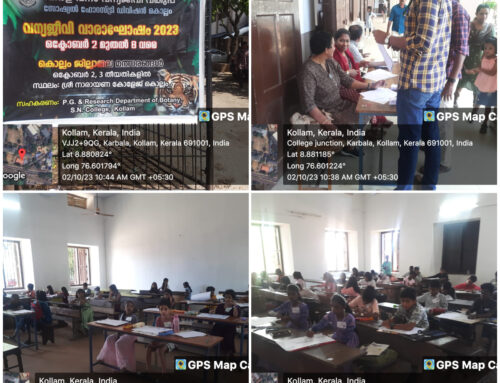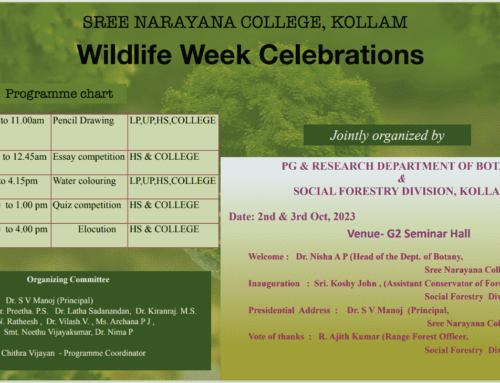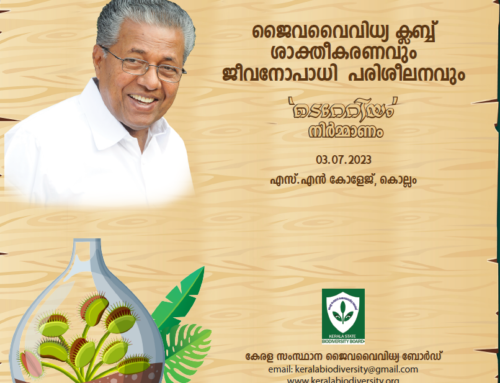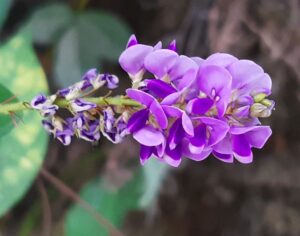
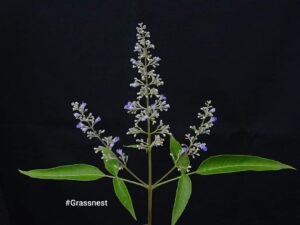
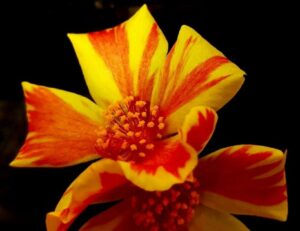
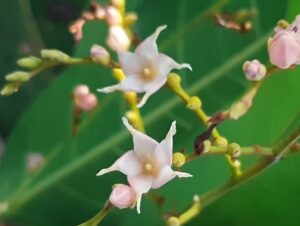
The Department of Botany offers consultancy and plant identification under the Botanical Information Service (BIS), an extension activity of the College, and the outreach programme of the Sree Narayana College Herbarium (SNCH). It provides herbarium reference and consultation, flowering plant identification, especially of fodder, forage, and weeds, including grasses and sedges, and general information on plants and authentication to researchers, the general public, government institutions, and ecological consultancies.
The plant authentication certificates are issued to researchers and students wherever necessary. Research individuals and institutions can deposit their voucher specimens at the International Herbarium of Sree Narayana College Kollam (SNCH).
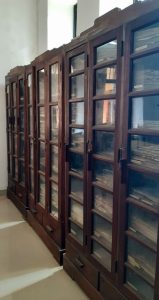 The SNCH is attached to the Postgraduate and Research Department of Botany, Sree Narayana College Kollam, which was established in 1949. A complete set of herbarium specimens from district floras (Kollam & Pathanamthitta) in Kerala State, India, were properly documented and managed at SNCH. The voucher specimens from internal as well as external botanical studies are added each year from 2016 onward. Presently, the herbarium houses 5035 specimens belonging to 134 families, 988 genera, and 2083 species, arranged by the Bentham & Hooker classification system. Digitalization of the College Herbarium (SNCH) started in 2022. Until February 2023, about 3000 plant specimens were digitally archived.
The SNCH is attached to the Postgraduate and Research Department of Botany, Sree Narayana College Kollam, which was established in 1949. A complete set of herbarium specimens from district floras (Kollam & Pathanamthitta) in Kerala State, India, were properly documented and managed at SNCH. The voucher specimens from internal as well as external botanical studies are added each year from 2016 onward. Presently, the herbarium houses 5035 specimens belonging to 134 families, 988 genera, and 2083 species, arranged by the Bentham & Hooker classification system. Digitalization of the College Herbarium (SNCH) started in 2022. Until February 2023, about 3000 plant specimens were digitally archived.
In 2023, SNCH was recognized and indexed in Index Herbariorum (IH), a guide to the world’s herbaria. For more details, visit Sree Narayana College Herbarium (SNCH)
Submission of Voucher specimens
A voucher herbarium specimen is a pressed plant sample with collection data deposited for future reference. It supports research work and may be examined to verify the identity of the specific plant used in a study. It is the responsibility of the collector or researcher to properly prepare, label, and sort specimens for submission, identification, and authentication. The following are the different steps for the deposition of specimens in SNCH:
- Download and fill out the SNCH Authentication form
- Establish official contact with the herbarium staff through the Head of the department
- Collect adequate plant material for identification or submission purposes (eg. flowers/fruits), which fill a herbarium sheet (The size of the herbarium sheet is 11 1/2″ X 16 1/2″ )
- Press the specimen when it is completely dried and neatly organized. Loose fruits should be secured in temporary paper packets.
- Mount the plant specimen and label it on the correct size of the herbarium sheet.
- Properly label the herbarium specimen with the help of a field book (Accession number, Date of collection, Locality, Name of species, Family, Habitat, Notes, Collectors Name)
- Submit the herbarium specimen (through surface mail or a personal visit) with a prescribed registration fee.
![]()
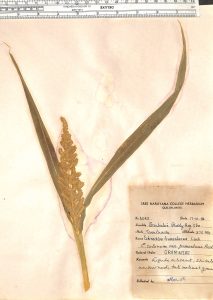
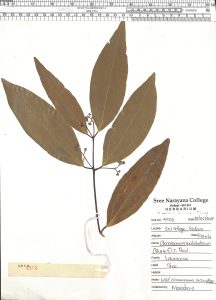
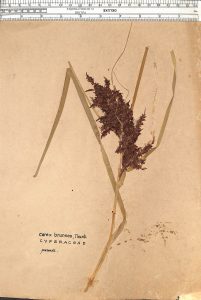
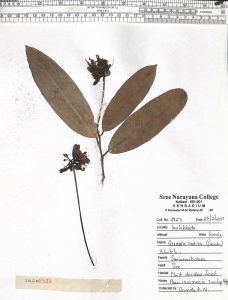
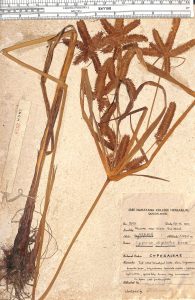
____________________________________________________________________________________________
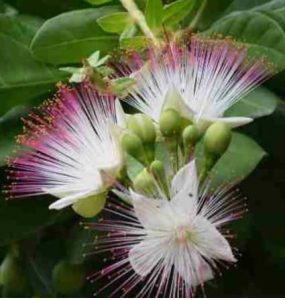 Name: Barringtonia asiatica (L.) Kurz ‘Fish poison tree’
Name: Barringtonia asiatica (L.) Kurz ‘Fish poison tree’
Family: LECYTHIDACEAE
Notes: This interesting tree was planted at the Botanical Garden of Sree Narayana College, Kollam (BGSNCK) in 1978, from the live collection of the Andaman & Nicobar Islands. All parts of this species are poisonous due to the presence of saponins. Its characteristic ‘box’ fruits are potent enough to be used as a fish poison. The seeds are ground to a powder and used to stun or kill fish for easy capture, suffocating the fish while the flesh is unaffected. The tree is considered a ‘flag species ‘of BGSNCK.
See more details at Hortus Keralae
________________________________________________________________________________________
Resources available at BIS
- Recognized Herbarium (SNCH), housed with about 5000 specimens under 2100 species of Angiosperms & Gymnosperms, arranged by the Bentham & Hooker system. A complete set of specimens of the flora of Kollam, Flora of Pathanamthitta, Sedges & Grasses of Kerala, exotic plants of Ooty, Tamil Nadu & Flora of the SNC Kollam campus were properly deposited.
- Equipment: Plant press (12 Nos.); A3 Digital Scanner (ScanSnap); Stereomicroscope with Image Projection System for plant identification purposes.
- Authenticated Taxonomic Literature and reference materials, including national and regional floras and manuals
- Subscribed Taxon, the Journal of International Association for Plant Taxonomy (IAPT), Systematic Botany, International Journal of the American Society for Plant Taxonomists (ASPT), Rheedea, the journal for Indian Association for Angiosperm Taxonomy (IAAT) & Current Science, the interdisciplinary science journal from the Indian Academy of Sciences (IAS). Hard copies of selected issues of the journals are now available at BIS.
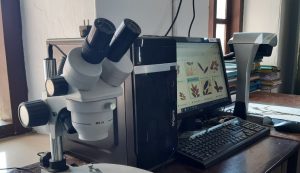
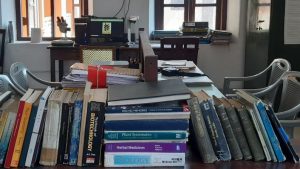
- Since 2016, Sree Narayana College Kollam’s BIS has produced BIS reports regularly. Ten reports have been released as of 2023 and are available to botanical enthusiasts. Three reports were previously released under the title “Botanical Survey Series” (2012-2015). Published BIS reports are:
- Trees of Sree Narayana College Campus, Kollam (June 2016)
- RET plants of Sree Narayana College, Kollam (June 2017)
- A field guide to medicinal plants of SNC Kollam Campus (June 2018)
- Biodiversity assessment of Asramam Biodiversity Heritage Site (ABHS), Kollam- I: Invasive plants (June 2019)
- A checklist of vascular plants of Sree Narayana College Botanical Garden (BGSNCK) (January 2020)
- E-handbook on Career Prospectus in Plant Science (September 2020)
- A photo essay on Flora of Sree Narayana College Campus, Kollam (January 2021)
- ESSENCEE Mini Forest (EMF), the arboretum of BGSNCK (December 2021)
- Sree Narayana College Herbarium (SNCH) (December 2022)
- Flora of Hortus Venad, the Botanical Garden of Sree Narayana College Kolam (March 2023)
- An associated Botanical Garden (BGSNCK) harbours various rare trees and medicinal & exotic plant species. The present checklist consists of 193 vascular plant species, including 174 angiosperms, 5 pteridophytes & 2 gymnosperms. The majority of the plants, especially woody plants, are digitally tagged with a QR code, based on the current botanical nomenclature system. See the updated checklist in the BIS Report (June 2020)
- Service of Herbarium Keeper every day from 10.00 a.m. to 3.00 p.m. IST (Monday-Friday)
On-line outreach programmes
- GRASSNEST, a weblog on biodiversity with special reference to botanical information (URL: https://grassnest.wordpress.com/).
- Hortus Keralae, an exclusive telegram channel which aims to document Kerala’s flowering plants, the ‘lockdown learning’ programme of BIS, which started during the Covid-19 pandemic period. (URL: https//t.me/keralaflora).
- Agrostology, a telegram channel for awareness on Indian grasses (URL: https://t.me/indiangrass/)
- GRASSNEST, where plant is an opportunity, a public telegram channel for Carrier guidance in Plant science (URL: https://t.me/grassnestgroup ) and associated private on-line groups for classroom discussions ( Mycologica: for 1st PG Botany, Taxonomica: for final PG botany; Botanicorum: for 1st UG botany, Anthophyta: for 2nd UG Botany, Chlorobionta: for final UG Botany; Plantarum: for UG Biotech)
- YouTube videos by Grassnest: (i) Flowers of Kollam District (ii) Mangroves of Kollam District
_______________________________________________________________________________
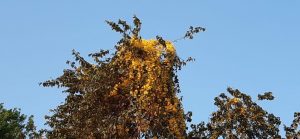
Plant Name: Dolichandra unguis-cati (L.) Miers. (syn. Bignonia unguis-cati) “Cats’ claw” vine
Family: BIGNONIACEAE
Note: It is a curious heat-loving climber, blooms at BGSNCK in Jan 2020, climbs with the help of ‘cat-claw’ like tendrils into the top of the trees. This specimen is usually given for anomalous secondary thickening practical classes under UG & PG programmes. See more details at Hortus Keralae
_______________________________________________________________________________
Officer-In-charge:
Dr KIRANRAJ, M.S., Assistant Professor in Botany & Curator of SNCH, Sree Narayana College Kollam, Kerala. Contact e-mail: [email protected]


